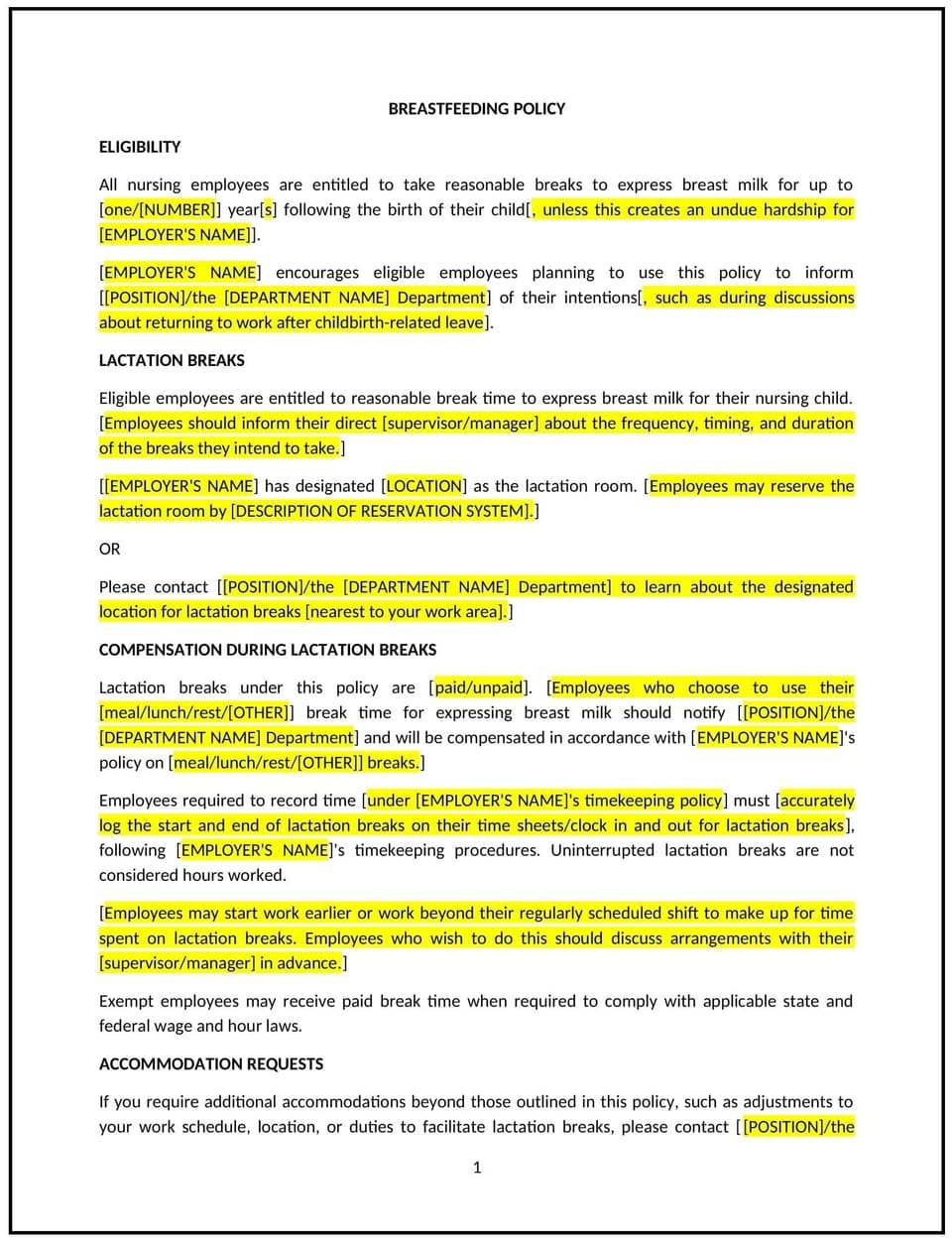Breastfeeding break policy (Kansas): Free template

Breastfeeding break policy (Kansas)
A breastfeeding break policy helps Kansas businesses support employees who need time and space to express milk during the workday. This policy outlines break accommodations, designated lactation spaces, and guidelines for ensuring a comfortable and private environment for nursing employees.
By implementing this policy, businesses can promote workplace inclusivity, support working parents, and create a positive work environment that meets the needs of nursing employees.
How to use this breastfeeding break policy (Kansas)
- Define break availability: Businesses should specify how often and for how long employees may take breastfeeding breaks during the workday.
- Designate private lactation spaces: Businesses should provide a clean, private space for nursing employees that is not a restroom. This space should have seating, an electrical outlet, and a secure door.
- Outline scheduling expectations: Businesses should establish a flexible process for employees to coordinate breastfeeding breaks while minimizing workplace disruptions.
- Address milk storage: Businesses should allow employees to store expressed milk in a personal cooler or a designated refrigerator, if available.
- Communicate employee rights: Businesses should inform employees about their right to breastfeeding breaks and how to request accommodations.
- Encourage supportive workplace culture: Businesses should promote an environment where nursing employees feel comfortable taking breaks without stigma or retaliation.
- Review and update regularly: Businesses should periodically assess the policy to align with workplace needs and best practices.
Benefits of using a breastfeeding break policy (Kansas)
- Supports working parents: Provides nursing employees with the flexibility to balance work and family responsibilities.
- Promotes employee retention: Encourages long-term workforce engagement by offering family-friendly policies.
- Enhances workplace inclusivity: Fosters a culture that respects and supports the needs of all employees.
- Reduces stress for nursing employees: Helps employees feel more comfortable returning to work after childbirth.
- Improves productivity: Allows employees to manage their needs effectively without added workplace stress.
- Strengthens company reputation: Demonstrates a commitment to employee well-being and family-friendly policies.
Tips for using this breastfeeding break policy (Kansas)
- Communicate break options clearly: Businesses should inform employees of their right to breastfeeding breaks and how to request them.
- Provide a comfortable lactation space: Businesses should ensure the designated space meets privacy and accessibility needs.
- Offer flexible scheduling: Businesses should accommodate reasonable break requests while balancing operational needs.
- Encourage manager training: Supervisors should understand the importance of breastfeeding breaks and how to support nursing employees.
- Maintain confidentiality: Businesses should respect employees’ privacy when handling breastfeeding break requests.
- Review policy effectiveness: Businesses should gather employee feedback to improve the policy as needed.
Q: Why should Kansas businesses implement a breastfeeding break policy?
A: Businesses should implement a breastfeeding break policy to support nursing employees, promote workplace inclusivity, and encourage employee retention. A structured policy provides clear guidance for both employees and management.
Q: How long and how often should breastfeeding breaks be allowed?
A: Businesses should allow reasonable break times based on individual employee needs. Many businesses provide two to three breaks per work shift, depending on the employee’s schedule and job duties.
Q: What should businesses include in a designated lactation space?
A: Businesses should provide a private room with a locking door, seating, an electrical outlet, and access to a clean water source. The space should not be a restroom.
Q: How should businesses handle scheduling for breastfeeding breaks?
A: Businesses should work with employees to create a break schedule that meets their needs while maintaining workplace efficiency. Breaks can be combined with regular rest or meal periods where feasible.
Q: Can businesses require employees to make up time taken for breastfeeding breaks?
A: Businesses should establish clear guidelines on whether breastfeeding breaks are paid or unpaid. Some businesses allow flexible scheduling to accommodate break time without requiring additional work hours.
Q: How should businesses store expressed milk in the workplace?
A: Businesses should allow employees to store milk in a personal cooler or provide access to a designated refrigerator, ensuring proper hygiene and security.
Q: How often should businesses review and update their breastfeeding break policy?
A: Businesses should review the policy annually or when workplace conditions change. Regular updates help maintain a supportive and effective policy.
This article contains general legal information and does not contain legal advice. Cobrief is not a law firm or a substitute for an attorney or law firm. The law is complex and changes often. For legal advice, please ask a lawyer.


